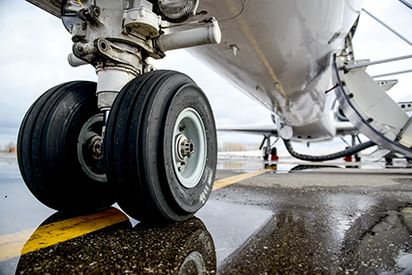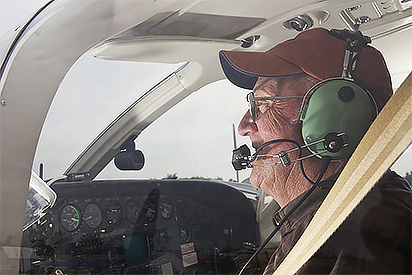
Uncommanded Swerving

Citing several runway excursions associated with nosewheel steering problems during the landing of Embraer EMB-145 regional jets, the U.S. National Transportation Safety Board (NTSB) is calling for new simulator training for uncommanded swerving during landing.
In a safety recommendation to the U.S. Federal Aviation Administration (FAA) in late January, the NTSB said the FAA should require operators of EMB-135s, EMB-140s and EMB-145s to incorporate the training into initial and recurrent simulator training.
The NTSB cited the June 7, 2013, landing of a China Eastern Airlines EMB-145LR in Shanghai during which the airplane veered off the left side of the runway and onto a taxiway.
None of the 49 passengers and crewmembers were injured in the landing but the airplane’s nosewheel landing gear was damaged. During the accident investigation, the nosewheel steering manifold assembly and the electrohydraulic servo valve (EHSV) were removed from the airplane and examined; foreign object debris (FOD) was found inside the EHSV housing “in an area where it could block a hydraulic port, subsequently leading to an uncommanded left nosewheel turn,” the NTSB said.
The FOD likely was pieces of an O-ring that were left inside the EHSV during manufacturing, the NTSB said.
The board said that tests found FOD in an EHSV from another EMB-145LR — an ExpressJet Airlines airplane that experienced a series of uncommanded swerving events at U.S. airports between March 19 and March 29, 2013. Tests of the valve found “a foreign gel-like substance” that probably “influenced the movement of the armature such that the EHSV induced an uncommanded left turn.”
“The NTSB is concerned that, in both of these cases, FOD capable of causing an uncommanded nosewheel turn was not able to be identified during the manufacturers’ acceptance tests,” the board said, recommending revised acceptance test procedures.
Other recommendations to the FAA and Embraer called for action to inform operators that Embraer has not approved use of binder brackets to hold chart binders and that a hazardous condition could result “if a binder becomes dislodged from the bracket.”
Settlement in UAS Penalty Case
The U.S. Federal Aviation Administration (FAA) has reached a settlement with a Chicago photography firm that it had accused of “endangering the safety of our airspace” with unauthorized operations of an unmanned aircraft system (UAS).

The agreement between the FAA and SkyPan International calls for the company to pay a $200,000 civil penalty and to pay additional fees if it violates Federal Aviation Regulations (FARs) within the next year or if it fails to comply with terms of the settlement, the FAA said.
The agency said that SkyPan also agreed to “work with the FAA to release three public service announcements in the next 12 months to support the FAA’s public outreach campaigns that encourage drone operators to learn and comply with UAS regulations.”
The FAA originally proposed a $1.9 million civil penalty against the company, which was accused of conducting 65 unauthorized operations between March 21, 2012, and Dec. 15, 2014, involving UAS aircraft “in some of our most congested airspace and heavily populated cities, violating airspace regulations and various operating rules.” The flights were conducted above Chicago and New York City, the FAA said.
The agency said the flights were conducted without a required airworthiness certificate and effective registration. Forty-three of the flights were in New York’s controlled airspace without the required clearance from air traffic control.
In the settlement, the FAA made no finding of a violation, and SkyPan said that the agreement allowed the company to “resolve this matter without any further expense or delay of business.”
The company said it “encourages all commercial UAS operators to carefully read Part 107 [the section of the FARs governing UAS use], to understand its requirements and limitations and to seek guidance from the FAA if they have any questions.”
MH370 Underwater Search Ends

Image: Peter D. Blair, U.S. Navy | Wikimedia
The underwater search for Malaysia Airlines Flight MH370, a Boeing 777 that disappeared March 8, 2014, en route from Kuala Lumpur, Malaysia, to Beijing with 239 people aboard, has been suspended.
The last search vessel left the underwater search area in mid-January, according to the Joint Agency Communication Centre, which represents government agencies that participated in the search.
“Despite every effort using the best science available, cutting edge technology, as well as modeling and advice from highly skilled professionals who are the best in their field, unfortunately, the search has not been able to locate the aircraft,” the three countries involved in the search — Australia, China and Malaysia — said in a joint statement.
Although several pieces of the airplane have washed ashore on Pacific islands, the search has failed to locate the main wreckage.
The joint statement held out hope that “new information will come to light” that will help locate the missing airplane.
Medical Issues for Older GA Pilots
“Critical medical factors,” including the use of medications such as anti-depressants and first-generation antihistamines, may be contributors to fatal accidents involving general aviation (GA) pilots older than 70, according to a study by an international group of medical researchers.

The study was based on a review of the U.S. National Transportation Safety Board (NTSB) accident database from 2003 through 2012 and was published in the February issue of the Aerospace Medical Association journal Aerospace Medicine and Human Performance. The study identified 114 fatal accidents involving pilots aged 70 to 92.
Of the 114 pilots, 17 percent had taken first-generation antihistamines, which many people use as sleep medication. Side effects of the drugs may include drowsiness, impaired thinking and blurred vision and, as a result, the medication may result in impaired performance, the report said.
The report said that antidepressants were found in 7 percent of the pilots and noted that, during the time period studied, U.S. pilots were prohibited from using the medications. The report added that older people taking antidepressants face “an increased risk of adverse outcomes.”
Mitigating ATC Disruptions

The U.S. Federal Aviation Administration’s (FAA’s) air traffic control (ATC) facilities are “not fully prepared” to respond to major disruptions in the system, a government watchdog agency says.
The Department of Transportation’s Office of Inspector General (OIG) said, in a report issued in mid-January, that the FAA must enhance controller training and take steps to ensure that ATC infrastructure has “the required redundancy, resiliency and flexibility” to respond to large-scale system disruptions.
“Many of the new technologies and capabilities that can improve the continuity of air traffic operations will not be available for years, and the agency’s procedures for updating contingency plans remain incomplete,” the report said. “While the agency has established new requirements for transferring airspace and air traffic control responsibilities to other facilities, those plans are not ready to be fully implemented.”
The report noted that the FAA has experienced several major system failures in recent years in which the effected facility was unable to provide ATC services, including a 2014 fire that destroyed essential equipment in the Chicago Air Route Traffic Control Center. As a result of the blaze, air traffic was disrupted nationwide, with normal ATC operations impossible for more than two weeks.
The OIG said that the FAA agreed with all eight recommendations contained in the report. Those recommendations included a call for the development and implementation of annual contingency plan training for controllers and for development and implementation of internal controls to test communication equipment, flashlights and other emergency equipment at air traffic control facilities.
Other recommendations call for officials of the Next Generation Air Transportation System (NextGen) to “evaluate, expedite and complete a report on how planned NextGen capabilities can enhance the resiliency and continuity of [National Airspace] operations and mitigate the impact of future air traffic control disruptions.”
No New Clues to ’85 Crash
Items discovered by hikers last year at the site of the 1985 crash of an Eastern Airlines Boeing 727 in Bolivia are not relevant to the accident investigation, the U.S. National Transportation Safety Board (NTSB) says.
In a statement released in early February, the NTSB said a damaged spool of magnetic tape was not from one of Flight 980’s flight recorders; instead, it was part of an episode of the 1960s television show “I Spy.” Other unspooled sections of tape also came from neither the cockpit voice recorder (CVR) nor the flight data recorder (FDR); the report did not elaborate on exactly what they were. The NTSB identified one piece of metal as a CVR rack, and said others “were consistent with parts related to the FDR pressurized container assembly.”
The NTSB said it had turned over its findings to the General Directorate of Civil Aviation of Bolivia (Unidad AIG), which had asked the NTSB to examine the items.
All 29 passengers and crew of the 727 were killed in the New Year’s Day crash, which occurred in dark night conditions and bad weather at the 19,600-ft level of Mount Illimani, about 25 nm (46 km) from the intended destination of La Paz. The flight had originated in Asunción, Paraguay.
Accident investigators examined the wreckage during a 1986 climbing expedition, but the flight recorders were never recovered.
In Other News …
Eurocontrol says 2016 was a record-setting year for network traffic with 10.2 million flights, up 2.8 percent from 2015, with an average of 27,844 flights a day. The previous record was set in 2008. Eurocontrol data also show that the busiest day ever — 34,594 flights — was recorded on Sept. 9, 2016. … The Civil Aviation Safety Authority (CASA) of Australia is arranging for an independent review of fatigue rules for operators and pilots in response to industry feedback on the new rules, which CASA says were updated in an effort to improve safety and align the industry with international standards. The review is expected to be completed by September, CASA said.
Compiled and edited by Linda Werfelman.
